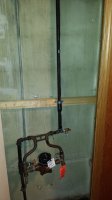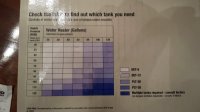I was doing some work on my irrigation system and one thing I did was check the water pressure. The houses water pressure coming from the city is 100 PSI. Is that too high? Should I install a Watts pressure reducing valve right after the meter? I'mm reading online that 100 is too high and 60 -70 seems good. The sprinkler system even says it should be 30-50 so I might even have install a second one before that.
There is a pressure reducing valve connected to the hot water radiator system which is set to 14psi, but that is kind of its own separate closed system. I have good flow to the house, even when a faucet or shower is on the pressure only drops to 90-95 psi.
Thanks for any help in advance
Jay
There is a pressure reducing valve connected to the hot water radiator system which is set to 14psi, but that is kind of its own separate closed system. I have good flow to the house, even when a faucet or shower is on the pressure only drops to 90-95 psi.
Thanks for any help in advance
Jay


